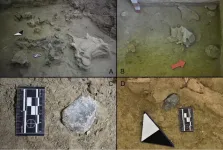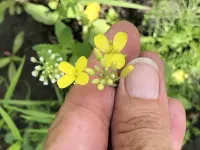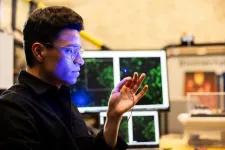(Press-News.org) Thousands of years ago, early hunter-gatherers returned regularly to Tagua Tagua Lake in Chile to hunt ancient elephants and take advantage of other local resources, according to a study published May 22, 2024 in the open-access journal PLOS ONE by Rafael Labarca of the Pontifical Catholic University of Chile and colleagues.
Multiple archaeological sites are known from the region of Tagua Tagua Lake in central Chile, representing some of the earliest known human settlements in the Americas. In this study, Labarca and colleagues report the recent discovery of a new site called Taguatagua 3, an ancient hunter-gatherer camp dating to the Late Pleistocene, between 12,440-12,550 years old.
Notably, this site features the fossil remains of a gomphothere, an extinct relative of elephants. Signs of butchery on the bones, along with stone tools and other evidence, indicate that Taguatagua 3 represents a temporary camp established around the task of processing the large carcass. Other activities were also carried out during the camp’s brief period of use, including processing of other foods as indicated by additional charred remains of plants and small animals such as frogs and birds. Fossil cactus seeds and bird eggshell suggest that this camp was occupied specifically during the dry season.
Numerous such sites of similar age are now known from this region, implying that Tagua Tagua Lake was a recurring hunting and scavenging ground for people during the Late Pleistocene due to abundant and predictable local resources. The authors suggest that this area was a key location along the routes taken by mobile communities of the time and that temporary camps might have hosted regular meetings between these mobile bands. Further investigation of this rich archaeological region will continue to provide insights into the mobility and subsistence strategies of early humans in South America.
The authors add: “Taguatagua 3 helps us to understand better how the early humans adapted to fast changing environments in central Chile during the late Pleistocene times.”
#####
In your coverage please use this URL to provide access to the freely available article in PLOS ONE: https://journals.plos.org/plosone/article?id=10.1371/journal.pone.0302465
Citation: Labarca R, Frugone-Álvarez M, Vilches L, Blanco JF, Peñaloza Á, Godoy-Aguirre C, et al. (2024) Taguatagua 3: A new late Pleistocene settlement in a highly suitable lacustrine habitat in central Chile (34°S). PLoS ONE 19(5): e0302465. https://doi.org/10.1371/journal.pone.0302465
Author Countries: Chile, Argentina, Spain, UK
Funding: This research was funded by ANID-FONDECYT Grants 11170919, 11220930, 1230860, Fundación Palarq Grant 2020-2022 and the Ilustre Municipalidad de San Vicente. Additional support was provided by FONDEQUIP EQM150101 (SEM-EDX) and FONDEQUIP EQM150020 (Confocal microscopy/RAMAN/AFM spectroscopy). The funders had no role in study design, data collection and analysis, decision to publish, or preparation of the manuscript.
END
Ancient people hunted extinct elephants at Tagua Tagua Lake in Chile 12,000 years ago
Multiple temporary campsites reveal recurring visits by early hunter-gatherers
2024-05-22
ELSE PRESS RELEASES FROM THIS DATE:
Twitter may be overlooking misinformation "superspreaders" - political pundits, low-credibility media outlets, and influencers who use more toxic language than the typical misinformation spreader
2024-05-22
Twitter may be overlooking misinformation "superspreaders" - political pundits, low-credibility media outlets, and influencers who use more toxic language than the typical misinformation spreader
###
Article URL: https://journals.plos.org/plosone/article?id=10.1371/journal.pone.0302201
Article Title: Identifying and characterizing superspreaders of low-credibility content on Twitter
Author Countries: USA, UK
Funding: This work was supported by the John S. and James L. Knight Foundation, Craig Newmark Philanthropies, and the National Science Foundation (grant ACI-1548562). The funders had no role in study design, data ...
Escaped GMO canola plants persist long-term, but may be losing their extra genes
2024-05-22
Populations of canola plants genetically engineered to be resistant to herbicides can survive outside of farms, but may be gradually losing their engineered genes, reports a new study led by Cynthia Sagers of Arizona State University, US, published May 22 in the open-access journal PLOS ONE.
The hypothesis has been put forward that if any genetically engineered crop plants escape farm fields, they will be short-lived. This would make them unlikely to take over wild areas or spread their inserted genes, called transgenes, to wild populations ...
Ancient Mycenaean armor tested by Marines and pronounced suitable for extended combat
2024-05-22
A famous Mycenaean suit of armor was not just ceremonial, but suitable for extended combat, according to a study published May 22, 2024 in the open-access journal PLOS ONE by Andreas Flouris of the University of Thessaly, Greece and colleagues.
One of the oldest known suits of European armor is a 3500-year-old suit found near the village of Dendra, a few kilometers away from ancient Mycenae. Since its discovery in 1960, it has been unclear if this was a ceremonial suit or if it was suitable for battle. This question has important implications for understanding ...
Health and economic benefits of breastfeeding quantified
2024-05-22
Breastmilk can promote equitable child health and save healthcare costs by reducing childhood illnesses and healthcare utilization in the early years, according to a new study published this week in the open-access journal PLOS ONE by Tomi Ajetunmobi of the Glasgow Centre for Population Health, Scotland, and colleagues.
Breastfeeding has previously been found to promote development and prevent disease among infants. In Scotland – as well as other developed countries – low rates of breastfeeding in more economically deprived areas are thought to contribute to inequalities in early childhood health. However, government policies ...
San Francisco study explores the growing culture of fentanyl smoking
2024-05-22
An interview-based study in San Francisco, CA, highlights individual experiences and local trends around fentanyl smoking, deepening understanding of this growing practice. Daniel Ciccarone of the University of California, San Francisco, and colleagues present their findings in the open-access journal PLOS ONE on May 22, 2024.
Use of illicitly manufactured fentanyl is associated with high risk of addiction, health issues, and exceptionally high overdose risk. Fentanyl significantly contributes to the escalating rate of drug ...
MIT scientists learn how to control muscles with light
2024-05-22
CAMBRIDGE, MA – For people with paralysis or amputation, neuroprosthetic systems that artificially stimulate muscle contraction with electrical current can help them regain limb function. However, despite many years of research, this type of prosthesis is not widely used because it leads to rapid muscle fatigue and poor control.
MIT researchers have developed a new approach that they hope could someday offer better muscle control with less fatigue. Instead of using electricity to stimulate muscles, they used ...
Smoking fentanyl, rising in SF, is a deadly new risk for overdose
2024-05-22
Now that smoking has replaced injecting as the most common way to consume fentanyl, UCSF researchers have uncovered an increased risk of fatal overdose from the residue that accumulates in smoking equipment.
The researchers found that people both shared fentanyl resin and consumed it accidentally. This may be increasing the risk of overdose, especially among those who use the equipment to smoke other drugs, like methamphetamine, and have not developed tolerance to opioids like fentanyl.
“The risk of overdose when sharing smoking devices with fentanyl resin could be seen as analogous to the risk of shared injection ...
3,500-year-old Mycenaean armor was suitable for extended battle - study
2024-05-22
A 3,500-year-old suit of Mycenaean armour may have been used in battle - and not just for ceremonial purposes as previously thought – new research reveals.
Researchers worked with a group of Greek military volunteers who wore a replica of the Dendra armour during extended simulations of the rigours of battle.
One of the best and most complete examples of Mycenaean-era full-body armour, the bronze panoply was discovered in a tomb in the Greek village of Dendra, by Greek and Swedish archaeologists in the 1960s. But since its discovery, the question has remained ...
Charité study in Nature: How cells deal with extra chromosomes
2024-05-22
Having extra chromosomes is typically an issue for an organism and can disrupt development or cause disease. But some cells benefit instead: For example, cancer cells or pathogenic yeasts can use extra chromosomes to escape treatment and become drug-resistant. A team of researchers from Charité – Universitätsmedizin Berlin has now deciphered how yeasts manage to compensate for the genetic imbalance. Their findings, published in the journal Nature,* could yield new approaches to dealing ...
SwRI highlights NEXTCAR II project innovations at 2024 ARPA-E Innovation Summit
2024-05-22
SAN ANTONIO — May 22, 2024 — Southwest Research Institute will share the latest developments from its ongoing NEXTCAR Phase II project at the 2024 ARPA-E Energy Innovation Summit in Dallas (May 22-24). The Institute’s NEXTCAR Program aims to reduce vehicular energy consumption by more than 30% using next generation connected and automated vehicle (CAV) technology.
“We are demonstrating real-world next-generation automated driving technology that puts SwRI’s ongoing NEXTCAR energy efficiency research into practice,” said SwRI’s Scott R. Hotz, P.E., director of the Powertrain ...
LAST 30 PRESS RELEASES:
SwRI upgrades nuclear magnetic resonance laboratory for pharmaceutical R&D
House sparrows in northern Norway can help us save other endangered animals
Crohn's & Colitis Foundation survey reveals more than 1/3 of young adults with IBD face step therapy insurance barriers
Tethered UAV autonomous knotting on environmental structures for transport
Decentralized social media platforms unlock authentic consumer feedback
American Pediatric Society announces Vanderbilt University School of Medicine as host institution for APS Howland Visiting Professor Program
Scientists discover first method to safely back up quantum information
A role for orange pigments in birds and human redheads
Pathways to net-zero greenhouse gas emissions for Southeast Asia
A JBNU–KIMS collaborative study on a cost-effective alloy matches superalloys for power plants and energy infrastructure
New study overturns long-held model of how plants coordinate immune responses.
New AI model predicts disease risk while you sleep
Scientists discover molecular ‘reshuffle’ and crack an 80-year-old conundrum
How stressors during pregnancy impact the developing fetal brain
Electrons lag behind the nucleus
From fungi to brain cells: one scientist's winding path reveals how epigenomics shapes neural destiny
Schizophrenia and osteoporosis share 195 genetic loci, highlighting unexpected biological bridges between brain and bone
Schizophrenia-linked genetic variant renders key brain receptor completely unresponsive to both natural and therapeutic compounds
Innovative review reveals overlooked complexity in cellular energy sensor's dual roles in Alzheimer's disease
Autism research reframed: Why heterogeneity is the data, not the noise
Brazil's genetic treasure trove: supercentenarians reveal secrets of extreme human longevity
The (metabolic) cost of life
CFRI special issue call for papers: New Frontiers in Sustainable Finance
HKU Engineering scholar demonstrates the smallest all-printed infrared photodetectors to date
Precision empowerment for brain "eavesdropping": CAS team develops triple-electrode integrated functional electrode for simultaneous monitoring of neural signals and chemical transmitters during sleep
Single-capillary endothelial dysfunction resolved by optoacoustic mesoscopy
HKU three research projects named among ‘Top 10 Innovation & Technology News in Hong Kong 2025’ showcasing excellence in research and technology transfer
NLRSeek: A reannotation-based pipeline for mining missing NLR genes in sequenced genomes
A strand and whole genome duplication–aware collinear gene identification tool
Light storage in light cages: A revolutionary approach to on-chip quantum memories
[Press-News.org] Ancient people hunted extinct elephants at Tagua Tagua Lake in Chile 12,000 years agoMultiple temporary campsites reveal recurring visits by early hunter-gatherers










